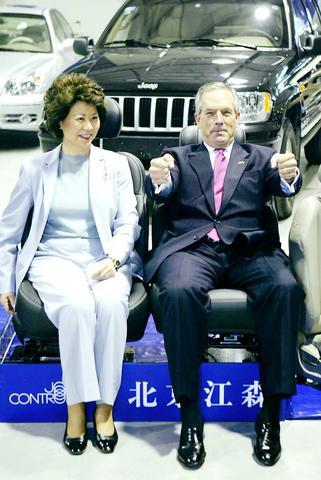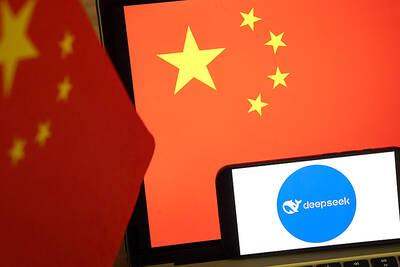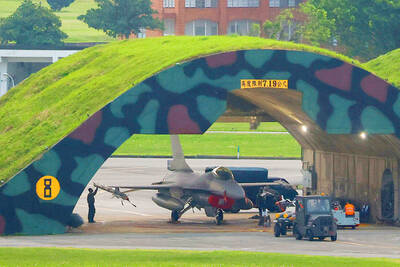The US urged China yesterday to wage a wider war against rampant patent and copyright piracy as it sought ways to reduce a growing trade imbalance that has become an election issue in the US.
Beijing needed to do much more to battle counterfeiting that had seriously harmed US firms and workers, US Secretary of Commerce Don Evans told reporters during a four-day visit to China.

PHOTO: EPA
"There needs to be much more efforts, much more resources put into the protection of intellectual property rights across the country," Evans told reporters during a visit to a factory in a Beijing suburb.
The Chinese authorities needed to do more at the provincial and city levels, he said, two months after Chinese Vice Premier Wu Yi (吳儀) pledged during meetings with Evans in Washington to intensify a crackdown on counterfeiting.
China's own State Council has estimated the market value of counterfeit goods in China at about US$19 billion to US$24 billion annually. The bogus trade affects a wide range of US products, including films, music, publishing, software, pharmaceuticals, information technology and automotive parts.
Washington also hoped to do more to reduce its trade deficit with the world's fourth-biggest trading nation, which hit a record US$124 billion last year and is expected to head higher.
"In the first four months of this year the trade deficit continued to grow, so we need to continue to work on ways to reduce those trade barriers," Evans said.
He also reiterated Washington's desire to see the yuan liberalized.
"We think it's very important to have a flexible, market-driven exchange rate. That coupled with free trade and free flow of capital," he said.
"There is a working group between the United States and China working on that and we will continue to work for it," he said.
Investors have speculated China may make the yuan more flexible as early as this year by pegging it to a basket of foreign currencies and letting it move more freely, a step many analysts expect would lead the currency to strengthen. Analysts say China will only do so in its own time, rather than bow to foreign pressure.
Evans also oversaw the signing of a series of deals between US and Chinese business yesterday, including an agreement by General Electric, the world's biggest maker of turbines, to sell two electric transfer systems to China Southern Power Grid Co.
Honeywell Inc, meanwhile, agreed to supply environmentally friendly refrigerants and other chemicals to home appliance maker Haier. No terms of the deals were given.
"These partnerships will grow American jobs and contribute to America's economic development," Evans said.
"These signings are an example of the strong commercial bonds being forged between the United States and China," he said
Also signed yesterday was a deal with United Solar Ovonic and Dawson International to provide and install a 300-kilowatt solar photovoltaic lighting system in the Beijing New Capital Museum.
Evans was scheduled to meet Chinese Premier Wen Jiabao (溫家寶) yesterday for talks that will also include US Secretary of Labor Elaine Chao who is in Beijing.
Today, Evans will meet separately with Vice Premier Wu Yi (吳儀), Vice Premier Zeng Peiyan (曾培炎) and Commerce Minister Bo Xilai (薄熙來) following a breakfast speech with US businesspeople.

MISINFORMATION: The generated content tends to adopt China’s official stance, such as ‘Taiwan is currently governed by the Chinese central government,’ the NSB said Five China-developed artificial intelligence (AI) language models exhibit cybersecurity risks and content biases, an inspection conducted by the National Security Bureau (NSB) showed. The five AI tools are: DeepSeek, Doubao (豆包), Yiyan (文心一言), Tongyi (通義千問) and Yuanbao (騰訊元寶), the bureau said, advising people to remain vigilant to protect personal data privacy and corporate business secrets. The NSB said it, in accordance with the National Intelligence Services Act (國家情報工作法), has reviewed international cybersecurity reports and intelligence, and coordinated with the Ministry of Justice Investigation Bureau and the National Police Agency’s Criminal Investigation Bureau to conduct an inspection of China-made AI language

BOOST IN CONFIDENCE: The sale sends a clear message of support for Taiwan and dispels rumors that US President Donald Trump ‘sold out’ the nation, an expert said The US government on Thursday announced a possible sale to Taiwan of fighter jet parts, which was estimated to cost about US$330 million, in a move that an expert said “sends a clear message of support for Taiwan” amid fears that Washington might be wavering in its attitude toward Taipei. It was the first announcement of an arms sale to Taiwan since US President Donald Trump returned to the White House earlier this year. The proposed package includes non-standard components, spare and repair parts, consumables and accessories, as well repair and return support for the F-16, C-130 and Indigenous Defense Fighter aircraft,

CHECKING BOUNDARIES: China wants to disrupt solidarity among democracies and test their red lines, but it is instead pushing nations to become more united, an expert said The US Department of State on Friday expressed deep concern over a Chinese public security agency’s investigation into Legislator Puma Shen (沈伯洋) for “secession.” “China’s actions threaten free speech and erode norms that have underpinned the cross-strait ‘status quo’ for decades,” a US Department of State spokesperson said. The Chongqing Municipal Public Security Bureau late last month listed Shen as “wanted” and launched an investigation into alleged “secession-related” criminal activities, including his founding of the Kuma Academy, a civil defense organization that prepares people for an invasion by China. The spokesperson said that the US was “deeply concerned” about the bureau investigating Shen

‘TROUBLEMAKER’: Most countries believe that it is China — rather than Taiwan — that is undermining regional peace and stability with its coercive tactics, the president said China should restrain itself and refrain from being a troublemaker that sabotages peace and stability in the Indo-Pacific region, President William Lai (賴清德) said yesterday. Lai made the remarks after China Coast Guard vessels sailed into disputed waters off the Senkaku Islands — known as the Diaoyutai Islands (釣魚台) in Taiwan — following a remark Japanese Prime Minister Sanae Takaichi made regarding Taiwan. Takaichi during a parliamentary session on Nov. 7 said that a “Taiwan contingency” involving a Chinese naval blockade could qualify as a “survival-threatening situation” for Japan, and trigger Tokyo’s deployment of its military for defense. Asked about the escalating tensions